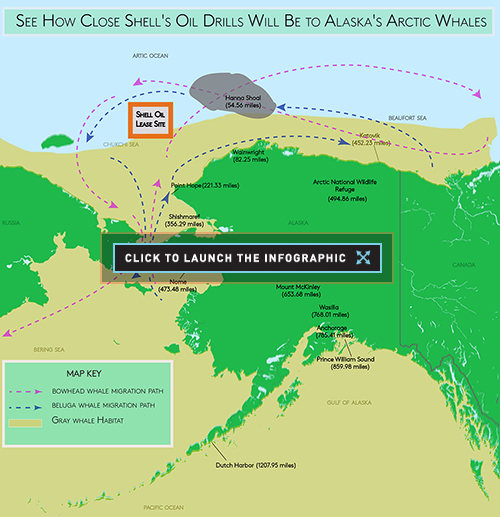SEE HOW CLOSE OIL DRILLING WILL GET TO ARCTIC WHALES THIS SUMMER
The region where Shell plans to sink wells is home to polar bears, walruses, seals, and other wildlife.
beluga whales swimming amid arctic ice
By Emily J. Gertz TAKE PART
Emily J. Gertz is TakePart’s associate editor for environment and wildlife.
Shell Oil received good news on Monday, when the Obama administration announced conditional approval of Shell’s plan for exploratory oil drilling in the Arctic Ocean in the summer.
The move gives the company six potential oil well sites in the Chukchi Sea to investigate. The lease area sits about 85 miles northwest of the town of Wainwright, off Alaska’s northern coast.
In the wake of Shell’s mishap-laden 2012 Arctic summer drilling season, the Bureau of Ocean Energy Management, which oversees offshore oil and gas extraction, has beefed up safety requirements.
But environmental advocates have criticized the Obama administration for renewing Shell’s permit, saying that no safety requirements can measure up to the tough Arctic conditions in this remote area or prevent a potential oil spill from harming wildlife.
The region’s east-flowing ocean currents might carry spilled oil to a protected marine area named Hanna Shoal, just 55 miles northeast of Shell’s lease area, where icy waters provide important habitat for whales, endangered polar bears, ice seals, and Pacific walruses. The coastal tundra of the Arctic National Wildlife Refuge, about 450 miles east of the lease area, is also prime habitat for polar bears, ice seals, migratory water birds, and caribou.
(Illustration: Lauren Wade/TakePart)
Growing noise levels and vessel traffic from energy prospecting are also threats to the region’s whales. Gray whales swim the waters of the Chukchi Sea year-round. Bowhead whales migrate east along the Chukchi coast in late spring, then back across open Chukchi waters in the fall. Beluga whales migrate through this part of the sea from May to September and raise young along the coast, directly south of the drilling sites.
Many of these animals are part of the traditional Native Alaskan diet. Under the BOEM-approved plan, Shell is supposed to coordinate its operations with coastal villages so that their hunts will not be disrupted, and to make special effort not to disrupt Pacific walruses when they are abundant near or on the coast in late summer.
These 7 Arctic Animals Are Most at Risk From Climate Change
As part of BOEM’s revised safety requirements, Shell must keep a second drill rig no farther than 1,200 miles from its main drilling site. The additional platform would be at the ready to sink a relief well in case of a blowout similar to the 2010 explosion of BP’s Deepwater Horizon oil platform in the Gulf of Mexico.
Shell must also cease drilling between Sept. 24 and Sept. 28, about one month before the expected return of autumn sea ice.
A recent study found that to fend off the worst impacts of climate change, all Arctic oil and gas must be left in the ground and unburned. But in addition to green-lighting some Arctic Ocean areas for drilling, the Obama administration has proposed opening up several sites off the Atlantic coast to energy extraction.








Follow Us!